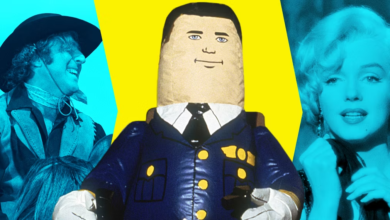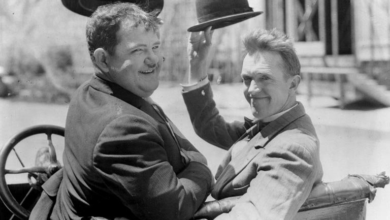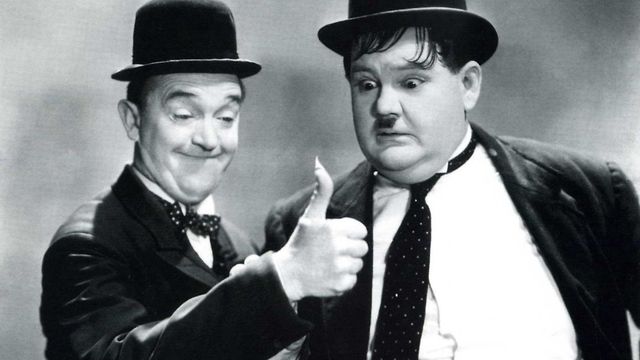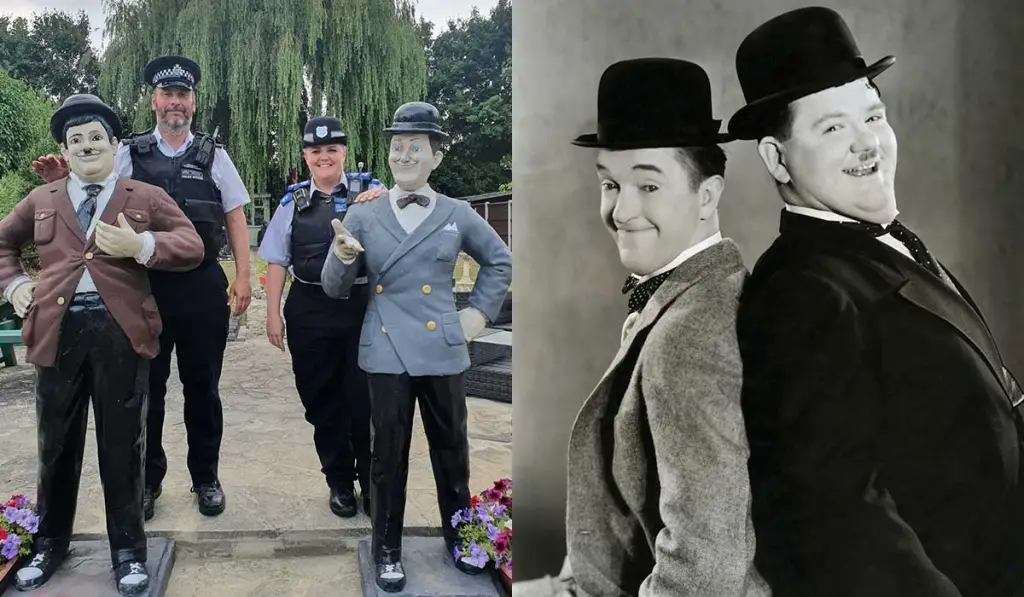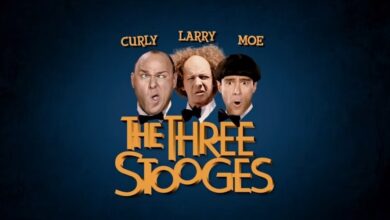Stan Laurel’s connection to Santa Cruz
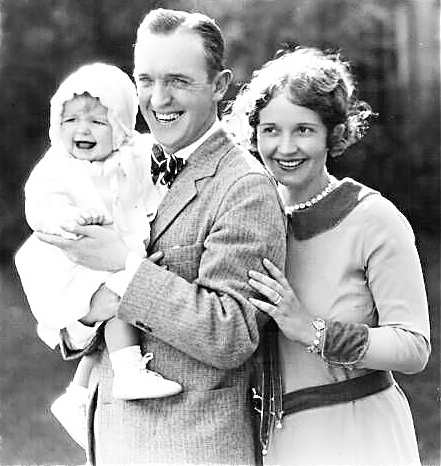
The film duo of Laurel and Hardy is in the category of All Time Great Hollywood comics. They’ve been claimed as the inspiration of numerous followers: Marcel Marceau, Jackie Gleason and Art Carney, Dick Van Dyke, and Johnny Carson. But Stan Laurel’s connection to Santa Cruz was through his first wife, Lois Nelson (sometimes spelled Neilson).

Laurel and Hardy poster for the 1934 film “Ghosts.” (Contributed)
Nelson was born in 1896 in the Central Valley town of Tulare, with sisters Lena and Stella. They enjoyed escaping to Santa Cruz in the summer to beat the valley heat. They moved permanently to Santa Cruz in 1909, living in Garfield Park circles, while her dad was a guard at the Davenport cement plant. They attended live shows downtown at the Mac Swain Theatre, until Swain and troop-member Nick Cogley went to Hollywood in 1911 to work for Mack Sennett’s Keystone Studios. Swain teamed-up with Ben Turpin to make “Ambrose & Walrus” comedies, pairing Swain’s short-tempered fat man against skinny Turpin’s dizzy optimism.
Nelson attended eighth grade at Bay View School, then enrolled at Santa Cruz High School in 1910, an exotic structure on Walnut Street with an onion-domed tower. Her classmates included Bob Houghton and ZaSu Pitts, both of whom appeared in School plays with Nelson. She seemed unflappable, asserting herself, yet disarming people with her humor and grace. The high school put on a circus in 1911 in which the trio played clowns. Then in 1912, Nelson, ZaSu, and schoolmate Carman Ballen (later Eddington, who became a screenwriter), appeared in the summer “Venetian Water Carnival” as chorus members in Gilbert & Sullivan operas on the river’s Opera Island stage. Then Nelson earned a basketball medal in June, 1913.
After summer vacation, Nelson started her senior year elected class president, and enjoyed use of the private Senior Study Hall lounge at the top of the high school’s tower. But a month later, a fire broke out in the basement chemistry lab, and the High School burned down Oct. 1, 1913. The rest of the year, classes were held in spare rooms scattered around town, with Freshman and Sophomores headquartered at Mission Hill School, and Juniors and Seniors 13 blocks west at Bay View Grammer School.
Few senior presidents had more challenges, but Nelson had a knack for crisis management as a bond-raising booster to build a new high school, for which William Weeks was chosen architect. At a time when most states didn’t even allow women to vote, Nelson impressed everyone with her political talent and good sense. The 1914 prom was held at the Boardwalk’s Casino Ballroom, and graduation ceremonies for Nelson and Pitts were held in the Boardwalk Theater, a cinema-with-stage which later became a movie studio. The class prophecy predicted Pitts would become “the most popular comedienne of the day,” and Nelson would be Bob Houghton’s campaign manager for mayor of Santa Cruz. Her sister Lena married Houghton in 1919.
Hollywood
While Pitts went to Hollywood to start a film career, Nelson entered nurses’ training at St. Luke’s Hospital in San Francisco. Then Pitts invited Nelson south in 1918, and soon she was also on her way to a film career. Nelson had the good look for films, but not exactly the stuff of film comedy, which at the time favored oddballs. But in 1918, Nelson was hired by Universal-head Carl Laemmle to do film comedies, and acted under Mac Swain’s former director Fred Fishback, as well as James D. Davis. Her first film was in a Hal Roach comedy “Do You Love Your Wife?” playing a hotel maid, opposite an unknown Stan Laurel as a janitor coming between an unfaithful husband and his wife.
Nelson then worked at Vitagraph in 1920, as part of the fast-paced “Montgomery & Rock” comedies. This stunt-comic duo consisted of Earl Montgomery playing bully to Joe Rock’s young boob. The short and stocky Rock didn’t consider himself either handsome or an actor, but Nelson found him dashing in his acrobatic grace, and easy-going personality. Nelson got along so well, she became Rock’s girlfriend.
When the series ended, Rock took Nelson to Federated in 1921. There, Rock was surprised to see an old friend from Vaudeville days, doing a Larry Semon picture. In spite of having acted together, Nelson and Laurel knew nothing of each other. Rock called Nelson a comedy actress with nerves of steel, quite fearless working with lions. Laurel was impressed by her daring.
Rock then told Nelson that Laurel had come to America in 1910 with Karno’s famous comedy troop, as Charlie Chaplain’s understudy. But the troop folded in 1912 when Chaplain went into movies, so Laurel entered Vaudeville, once touring as a Chaplin impersonator. When Rock toured with Laurel in 1916, Laurel had an act with Mae Dahlberg called “Mr. & Mrs. Stan Jefferson,” playing the part of a shrew and her hen-pecked husband. Mae changed his named to “Stan Laurel,” so his name wouldn’t have 13 letters. Even though they weren’t married, the act was barely fiction, as Rock would hear them argue in their dressing room night-after-night.
Laurel made sporadic attempts to launch a film career, but studio after studio dropped him for lacking a consistent persona, or because Mae was too much to deal with. Bronco Billy Anderson (relocated from Niles to Hollywood) was the only one who’d understood Laurel’s gift, and as director, helped him showcase his versatility. He got Laurel to develop a sympathetic character, which raised slapstick comedy to a different level. Laurel’s not-so-bright character, was so loyal and eager-to-please that his infuriating screw-ups were eventually forgiven out of pity.
Laurel’s success with Anderson was such that Hal Roach Studios (who’d previously dropped Laurel) lured him back in 1923 with a salary neither Anderson nor Rock could match. Meanwhile, Nelson and Rock’s romance cooled, although he and Nelson remained lifelong friends. Rock would soon marry Nelson’s best friend Louise.
Laurel worked at Roach under director Charles Parrott (Charlie Chase), but when his contract with Roach ended in 1924, and Laurel couldn’t pay the rent, he moved in with his director, Perce Pembroke. Rock made Pembroke part of the deal to direct Laurel, but deliberately didn’t include Mae, who didn’t like being excluded. But Rock wouldn’t budge, confronted Mae, and eventually got her to back down. Laurel began drinking, as Mae pressured him to quit films and go back on the stage as her partner. Mae thought of herself as Laurel’s wife (even though she was married to an actor in Australia). Rockound out Mae’s price to return to Australia, and paid it.
On the dreary stormy morning Mae departed, Laurel was brought to Nelson’s house with Rock, served hot toddies by a roaring fire, while Nelson prepared pot roast in the kitchen. A phone call confirmed Mae was shipboard and underway to Australia, at which Laurel leapt up and exclaimed “I’m free!” Rock soon made excuses and departed before lunch, leaving Laurel and Nelson to a private meal, which kindling the love-fires, and Laurel moved-in to Nelson’s house several weeks later.
A new start
Nelson was everything Mae wasn’t: young, pretty, supportive, humorous and with an underlying rock-hard practicality. Rock may have viewed this relationship as bringing some stability to Laurel’s life, and protecting his investment. But Laurel regarded Nelson as the one true love of his life. When Nelson’s father died on Feb. 11, 1926, Laurel proposed marriage so she could give her family some good news when returning to Santa Cruz for the funeral. They married on Aug. 13, Nelson giving up her film career to be wife and a savvy manager for Laurel’s career. Part of the “Laurel & Rock” series had been filmed in a short time, then released monthly, leaving Laurel under contract but unpaid for five months, with half-a-year of unpaid releases to go. Nelson and director Pembroke protested to Rock, and Laurel was allowed to write and direct for Roache Studios around June, a temporary arrangement that became permanent.
Laurel was quite content behind the camera as writer/director, and only reluctantly took over a part vacated by an actor injured in a cooking accident in 1926, named Oliver Hardy. They first appeared as an official duo in 1927, and slowly developed their identity.

Laurel and Hardy are basically children in an adult world, always getting into trouble, forging disastrously ahead in spite of overbearing wives, bosses, cops and sergeants. Hardy based his personality on a comic strip character “Helpful Henry,” a fussy, know-it-all always trying to save the day, but messing up profoundly. Hardy always assumed Laurel was too dumb to do things right, and insisted on doing them himself, which always backfired. Laurel’s character was so innocent, he would do impossible things because he didn’t know it’s impossible. Even when they’re silent, their reactions are priceless. And though the characters fought constantly, they’d always make-up, and stay friends.
Laurel and Nelson had a daughter named Lois, born Dec. 10, 1927. Their son Stanley was born two months premature in 1930, and only lived for nine days. Laurel sought solace elsewhere, leading to his divorce from Nelson in 1934, and while they remained good friends, Laurel always regretted losing her. Hoping to win her back, that year he built a brick house for her mother Ella, in Santa Cruz, at the end of Rathburn Way. It looks like a William Wurster design, who was developing the early Pasatiempo Ranch House style.
Laurel visited Santa Cruz on several occasions thereafter, once to see Hollywood friend Margaret Harris and her teenage son Clark Johnson, living at what’s now the Casablanca on Beach Hill.
When Laurel and Hardy were touring a Vaudeville act starting at the San Francisco Fox, they had Clark buy some suits at the Santa Cruz Goodwill, to turn into loosely-stitched tear-away clothes.

